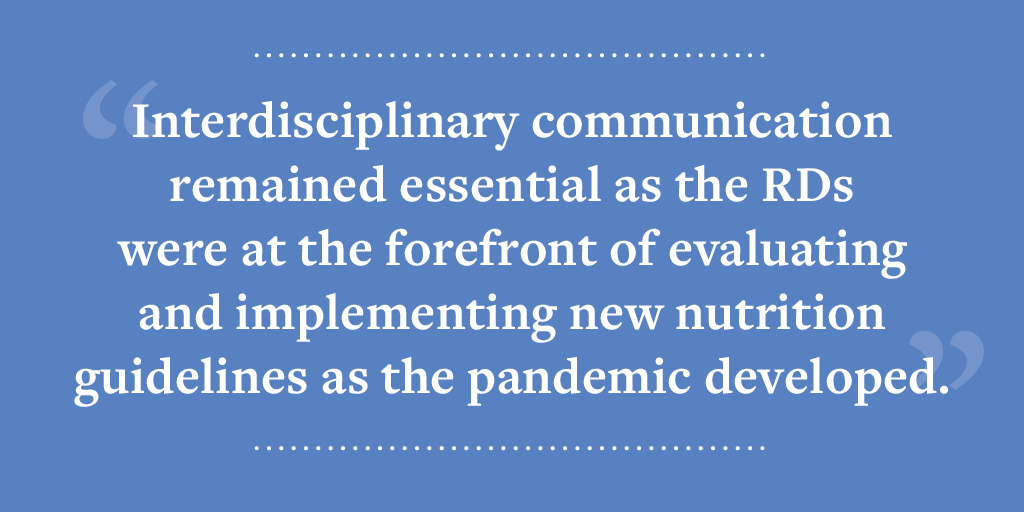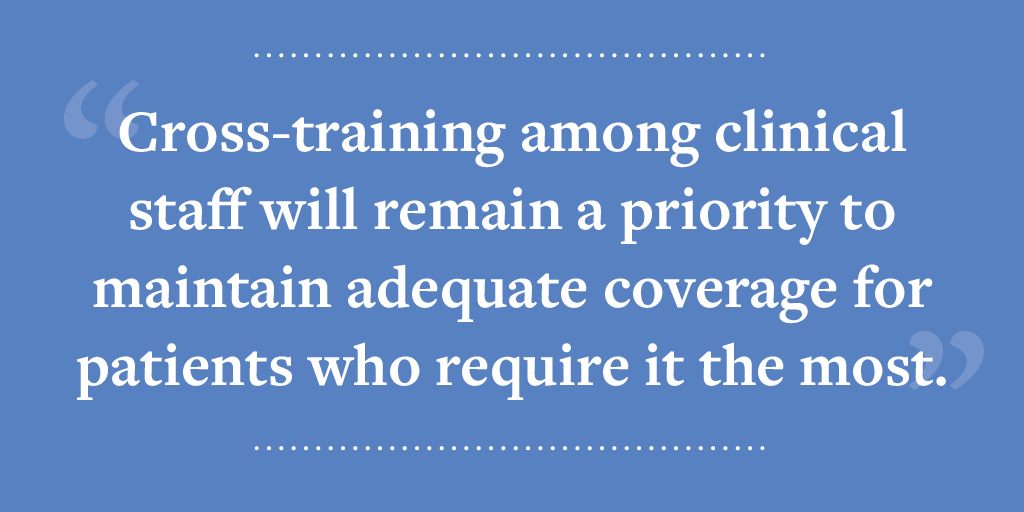How a Food and Nutrition Services Department responded to the pandemic
By Nidhi Gupta and Alexander Gavronsky
Staten Island University Hospital, a part of the Northwell Health, is a hub to many who fall under the umbrella of highly regarded healthcare heroes. Amongst these are members of the Food & Nutrition Services department, including dietary supervisors, patient dining associates, foodservice directors, and registered dietitians (RDs) to name a few.
The surge of the COVID-19 pandemic became an undeniable reality quickly, and the entirety of the department became an example of adapting creative solutions to overcome unexpected problems. As they say, food is medicine, and ensuring a solid foundation behind the process in which food reached the patient, the family, or the healthcare team was crucial.
As the number of COVID cases increased, communication was important as ever. Our foodservice staff needed to be aware of new personal protective equipment (PPE) guidelines. Unit designations had changed and our staff needed to learn about COVID free units and COVID+ units.
 Workflow had to be adapted to delivering trays to COVID+ units while avoiding contamination of foodservice staff. Disposable trays were introduced for these units, and demand for them increased over time resulting in one of the first major challenges – availability of product. Eventually we transitioned all meals into disposable containers, requiring more product than previously forecasted. Product shortages became the reality, and alternatives had to be considered. Creative solutions included using product donated by local businesses, such as pizza boxes, while vendors worked to meet the increased demand.
Workflow had to be adapted to delivering trays to COVID+ units while avoiding contamination of foodservice staff. Disposable trays were introduced for these units, and demand for them increased over time resulting in one of the first major challenges – availability of product. Eventually we transitioned all meals into disposable containers, requiring more product than previously forecasted. Product shortages became the reality, and alternatives had to be considered. Creative solutions included using product donated by local businesses, such as pizza boxes, while vendors worked to meet the increased demand.
Once product demand was met, the next step was to order emergency rations to ensure we had enough if there were potential shortages in the future. However, with such an increase of in-house product, space also became limited, and the kitchen couldn’t feasibly hold the additional product. As the café itself was seeing less traffic due to social distancing, the solution became to use the café itself as a means to hold emergency rations.
With the mental toll of the pandemic, as well as changes in hospital policy, the retail department was significantly affected. Since families could no longer visit their admitted loved ones, purchases in the café began to slow down.
To adapt, we transitioned the café menu to mimic the patient menu, allowing the department to optimize use of time and resources. To help avoid exposure, the café introduced new policies. Guests no longer served their own coffee or created their own salad – now food service staff were assigned to perform these tasks. The café moved to 24/7 service to assist evening staff & introduced groceries for purchase, including grab & go meals, cleaning supplies, and hygiene items.
The toll of labor
These changes also increased staff requirement in the clinical sector. Where a critical care RD would previously assess four or five critical patients on an average day, they were now assessing more than 10 daily. Interdisciplinary communication remained essential as the RDs were at the forefront of evaluating and implementing new nutrition guidelines as the pandemic developed.

The fear of exposure and the emotional toll witnessing the numbers rise as patients became sicker weighed heavily on the clinical staff. The threat of spending hours in a hospital, only to come home and expose at risk family members was always looming. As such, many RDs were no longer visiting their families through multiple week periods. Department-wide emotional support and comradery was all the more important to ensure RDs still had a support system during these changes. The constant reminder that risk is always present continued to motivate staff to take all precautions necessary. RDs with children had to adapt to the changing tides brought by school closures and remote school work. Management’s understanding of this change was important, allowing accommodation in schedule creation to allow these RDs to find the balance they needed.
Using every resource
As critical care cases continued to increase, use of tube feeding products increased beyond regular usage. A two-week emergency ration was created prior to the surge, but as the critical care patient load continued to rise, this two week supply soon became comparable to a two day supply. As with the case of disposable trays, seeking other vendors to exhaust every potential avenue was essential to obtain the products needed.
Eventually, when it became clear that a vital product in the formulary had a national shortage, action had to be developed to provide an adequate alternative. Communicating with the Nutrition Support Team to discuss appropriate substitutions and communicating with the hospital command center to quickly approve substitutions allowed the department to start utilizing alternatives with minimal compromise to patient care. Afterwards, communication with nurses, doctors, and dietary staff occurred daily to clarify product shortages and appropriate substitutions.
Looking towards the future
We will continue to feel the impact of the pandemic in the department culture and workflow. Preventing exposure will continue to highlight the importance of availability and appropriate use of PPE for staff.
Now that a baseline has been established, more accurate emergency ration forecasts can be made to avoid time spent seeking vendors who can provide out of stock products. This applies to labor as well, setting a precedent for the type of demand expected from the clinical and dietary sectors of the department.

Cross-training among clinical staff will remain a priority to maintain adequate coverage for patients who require it the most. The creative solutions implemented to obtain essential product during times of shortages will remain as a template. Beyond food supplies and supplements, communication of appropriate safety protocols, access to PPE and emotional support remains a priority to ensure the essential workers at the forefront are taken care of.
Ultimately, the current pandemic has made it clear that despite all of the preparation taken, one can never assume everything has been accounted for. How one adapts in the face of the unexpected, both as individuals and as a group, will be just as an important gauge for success in appropriately responding to the situation. There will always be more that can be done, but taking what has been learned through the precedent set will give us the lead necessary to make sure we are prepared to handle every step of the unknown.




